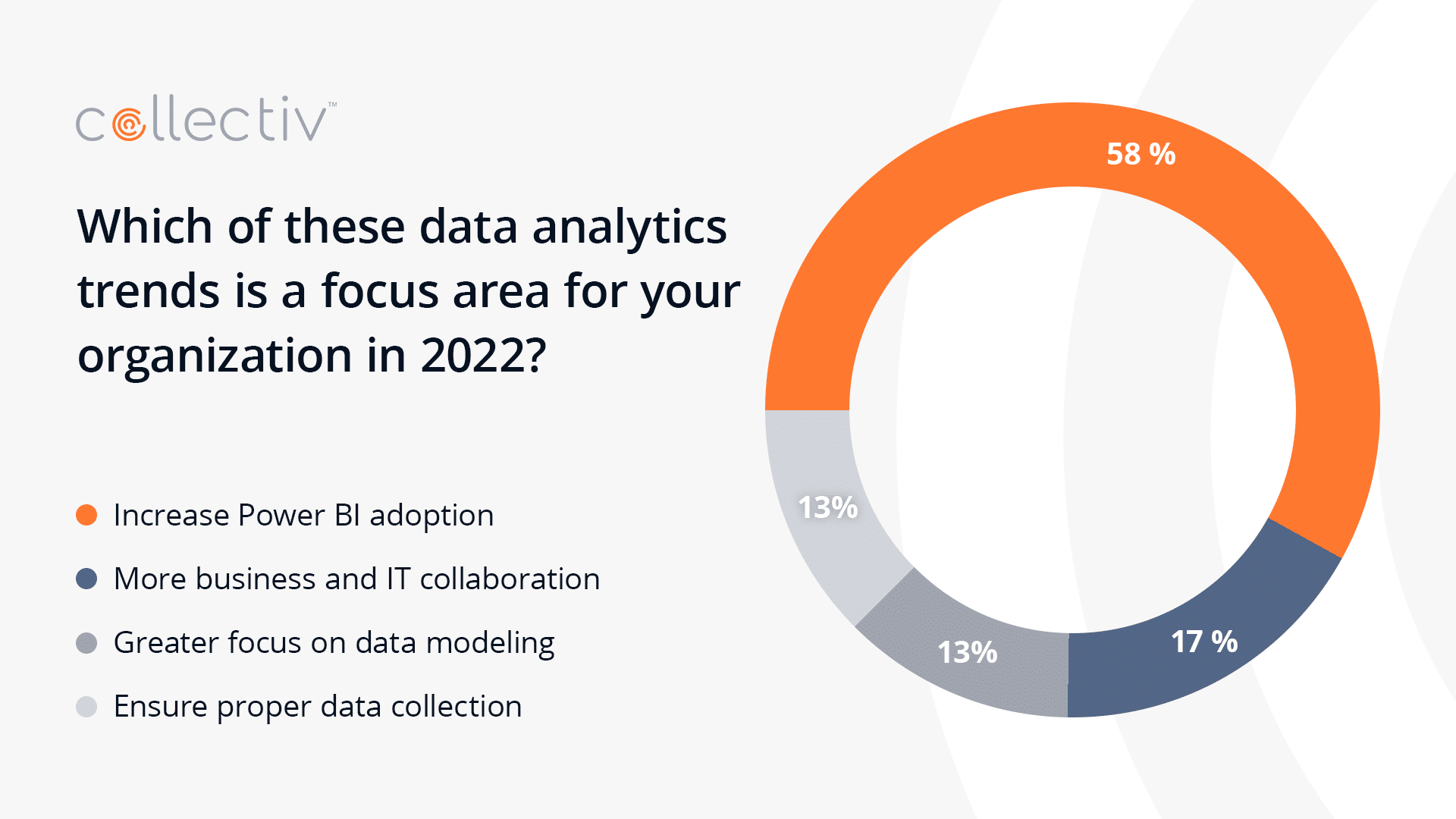As we face the long road ahead of a brand new year, it can be tough to figure out where we should focus the majority of our efforts so we get the results we need.
To figure out where other teams are at, we asked our LinkedIn followers about their data analytics priorities in 2022 and found out that:
- 58% want to increase Power BI adoption.
- 17% want more business/IT collaboration.
- 13% want a greater focus on data modeling.
- 13% want to ensure proper data collection.
Now is as good a time as any to figure out your focus area for the year.
To help you out, all of the principals here at Collectiv (myself included) got together to discuss which 2022 data analytics trends will have the greatest potential to impact your organization. We hope these insights give you some clarity and also help you find the best path forward.
Continuing the Growth of Managed Services
We will continue to see the growth of managed services, especially those that make machine learning and analytics easier—whether that means more from Azure and other cloud providers, or whether that means third-party services. This growth has been big over the last couple of years and it will keep going.
Look at a tool like Snowflake, for example. What Snowflake does best is data integration. The next big thing in data analytics isn’t always fancy AI stuff. More of the same is what we’ll see and that’s also a positive thing.
Rebalancing Disaster Prevention
A rebalancing of disaster prevention will be a priority in 2022. Because of COVID, there was a huge correction and a lot of players in the market had to pay a penalty for not being disaster-resistant.
Even after everything that has happened, data analysts still aren’t prepared. There will be another reckoning to ensure proper data collection and analysis. There is still a great need to take a wide lens perspective towards what’s possible.
The world hasn’t fundamentally changed just because it’s a new calendar year. But, it’s a good reminder to look for new opportunities to put our business ahead and find ways to make analysis impact new areas of the business. These needs are paramount.
Speeding Up Adoption
We’ll see a speeding up of the adoption of technology and automation to get to the right kind of analytics, and therefore, data-driven insights. Technology like Power BI has been a catalyst for getting what should have been done years ago done right now.
A lot of organizations and areas are hurting, especially in the supply chain. Things that may have been on the back burner are definitely on the front burner now.
Narrowing the Technology/IT Gap
We’ll continue to observe a narrowing of the traditional gap between technology/IT and the business. These business units will become more cohesive—out of necessity, but also because of technology evolving. IT and non-IT team members will be more open to working in partnership mode this year, rather than being stuck in their old silos.
Focusing More on Data Modeling
Data modeling, including what-if analysis and scenario analysis, has been and will continue to be a big focus for enterprises. Traditionally, these analytics have been rearview mirror insights, which are incredibly restrictive.
Now with things changing on a dime, a lot of organizations are focusing less on historical analysis. Instead, they are looking at the future and trying to predict it by what they can model out, so options are available as soon the organization needs to pivot or react.
Increasing Power BI Adoption Success
More and more non-IT team members (analysts and engineers) are realizing that tools like Power BI are available to help them save a lot of time in their day-to-day jobs. Power BI adoption will see a much higher success rate in 2022 as these end-users both accept and embrace more powerful tools instead of being limited to Excel.
Enhancing Applications with Analytics Tools
Organizations will continue to build their own applications, but they are realizing the benefit of using a tool like Power BI Embedded to provide their customers with analytics as well. While they may have had simple reporting before, now application developers are enhancing their products with analytics based upon their application. And they can do that with Power BI.
Transitioning Into Data-Driven Organizations
We’ll start seeing even more organizations transition into becoming data-driven organizations. Rather than the old adage of “this is how we’ve done it,” enterprise teams will use data to drive their decisions and transform processes.
Technology like Power BI is really driving this transition. It’s never been easier to collect information to the nth degree—then massage, transform, and present data in a more meaningful way. So we’re going to see a continuous and substantial increase in data-driven companies.
____________
As your organization moves forward into 2022, you already understand the need for data analytics tools but you’re also realizing that your team needs to focus on a whole laundry list of priorities. You might find that the solutions you invested in aren’t being fully leveraged.
Collectiv is here to lend support by facilitating your data analytics efforts, whether you need staff augmentation, Power BI implementation, or Consulting as a Service (CaaS). Reach out if you need guidance or consider kicking off the year strategically with our Visioning program.






























